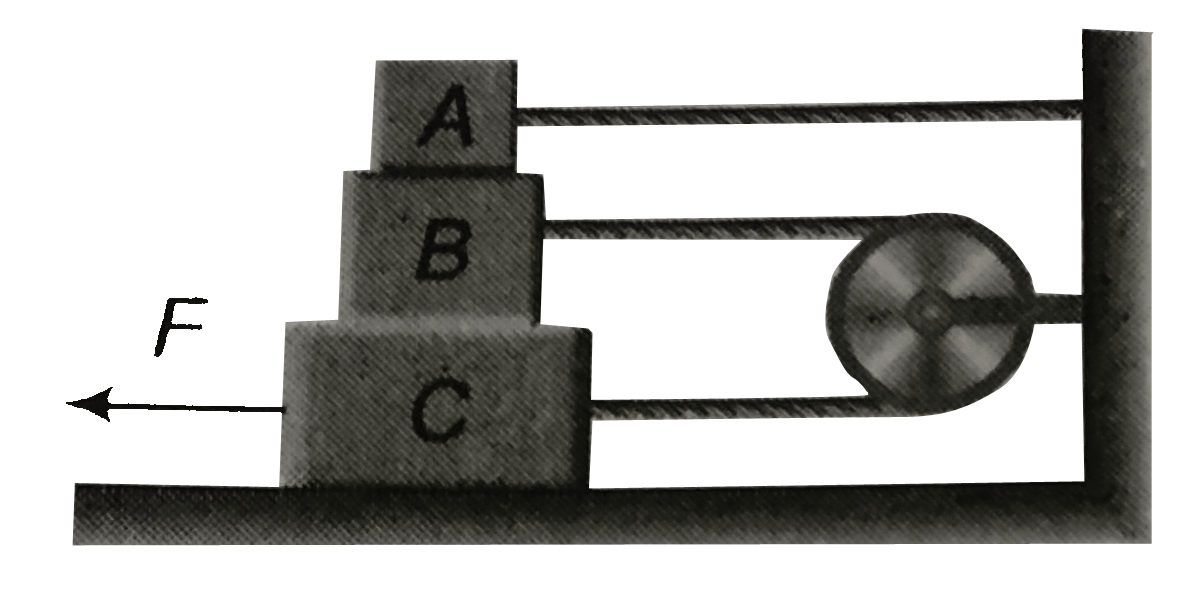A,B and C are the three blocks of masses 3 kg , 4 kg and 8 kg respectively. The blocks are placed over one another Fig. Coefficient of friction between each pair of surfaces in contact is 0.25. A is connected to the wall by a massless rigid rod, B and C are connected by an inextensible thread passing over a rigidly fixed smooth pulley. Find the force F required to pull C at a constant speed.

Let the weights of the blocks A, B and C be denoted by WA,WBandWC respectively. When the block C moves to the with uniform velocity, B moves to the right and A remains stationary. Hence the tension on the thread connected to B is equal to the sum of the forces of friction acting on the upper and lower surfaces of B.

∴ From the free body diagram of B ,
tension, T = fs+fk1=μ×WA+μ(WA+WB)
=0.25 (3+3+4)×g=2.5×g
For C to move at a constant speed T and frictions on the upper and lower surfaces of C, together should be equal to F.

∴ From the free body diagram Fig of C,
F = T +fk1+fk2
= T + μ(WA+WB)+μ(WA+WB+WC)
= 2.5×g+0.25(3+4)×g+0.25(3+4+8)×g
= 8×9.8 = 78.4 N.
Topper's Solved these Questions
- FRICTION BOOK - CHHAYA PUBLICATIONCHAPTER - FRICTION EXERCISE - Section Related Questions
9 Videos
- FRICTION BOOK - CHHAYA PUBLICATIONCHAPTER - FRICTION EXERCISE - HIGHER ORDER THINKING SKILL ( HOTS ) QUESTIONS
14 Videos
- FIRST AND SECOND LAW OF THERMODYNAMICSBOOK - CHHAYA PUBLICATIONCHAPTER - FIRST AND SECOND LAW OF THERMODYNAMICSEXERCISE - CBSE SCANNER
18 Videos
- HYDROSTATICSBOOK - CHHAYA PUBLICATIONCHAPTER - HYDROSTATICSEXERCISE - CBSE SCANNER
1 Videos
Similar Questions
In the diagram shown, the blocks A, B and C weight, 3kg, 4kg and 5kg respectively. The coefficient of sliding friction between any two surface is 0.25. A is held at rest by a massless rigid rod fixed to the wall while B and C are connected by a light flexible cord passing around a frictionless pulley. Find the force F necessary to drag C along the horizontal surface to the left at constant speed. Assume that the arrangement shown in the diagram, B on C and A on B, is maintained all through. (g=9.8m/s2)

View SolutionTwo masses of 10 kg and 20 kg are connected with an inextensible string passing over two smooth pulleys as shown in the figure. The acceleration of 20 kg mass will be :

View Solution
Knowledge Check
Two blocks of masses of 40 kg and 30 kg are connected by a weightless string passing over a frictionless pulley as shown in the figure.
 A0.7ms−2B0.8ms−2C0.6ms−2D0.5ms−2
A0.7ms−2B0.8ms−2C0.6ms−2D0.5ms−2Two blocks of masses of 40 kg and 30 kg are connected by a weightless string passing over a frictionless pulley as shown in the figure.
 A0.7ms−2B0.8ms−2C0.6ms−2D0.5ms−2
A0.7ms−2B0.8ms−2C0.6ms−2D0.5ms−2MA=3kg,MB=4kg,MC=8kg. Coefficient of friction between any two surface is 0.25 pulley is frictionless and string is massless .A is connected to wall through a massless right rod.
 Avalue of F to keep C moving with constant speed is 80NBvalue of F to keep C moving with constant speed is 120NCif Fis200N then acceleration of B is 10m/s−2Dto slide C towards left ,F should be at least 50N (Take g=10m/s−2)
Avalue of F to keep C moving with constant speed is 80NBvalue of F to keep C moving with constant speed is 120NCif Fis200N then acceleration of B is 10m/s−2Dto slide C towards left ,F should be at least 50N (Take g=10m/s−2)
Two masses of 10 kg and 20 kg are connected with an inextensible string passing over two smooth pulleys as shown in the figure. The acceleration of 20 kg mass will be :

View SolutionMA=3kg,MB=4kg,MC=8kg. Coefficient of friction between any two surface is 0.25 pulley is frictionless and string is massless .A is connected to wall through a massless right rod.

View SolutionThree blocks of masses 3 kg, 6 kg and 1 kg are connected by a string passing over two smooth pulleys attached at the two ends of the horizontal surface. If the co-efficient of friction between the block and the surface is 0.6, the frictional force acting on the block of mass 6 kg is

View SolutionThree blocks of masses 3 kg, 6 kg and 1 kg are connected by a string passing over two smooth pulleys attached at the two ends of the horizontal surface. If the co-efficient of friction between the block and the surface is 0.6, the frictional force acting on the block of mass 6 kg is

View SolutionTwo blocks A and B , each of mass 10kg , are connected by a light string passing over a smooth pulley as shown in the figure. Block A will remain at rest if the friction on it is

View Solution
